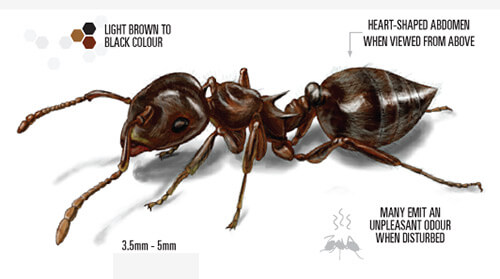Identification
- Colour Brown or yellowish brown to black or reddish black
- Size From 2 mm to 4 mm long; queens can be as long as 11 mm
- Body Acrobat ants have a heart-shaped abdomen joined to the thorax by two node segments.

How to identify Acrobat Ants
When acrobat ants feel threatened, they raise their abdomen over the head and thorax as a sign of defence. The acrobatic configuration resembles that of a scorpion’s arched tail and gives the species its name. Various species of acrobat ants can be found throughout North America. They nest and shelter under rocks and wood, as well as in walls and structures already damaged by wood-boring insects, moisture, or fungi. As such, acrobat ants are often considered structure-infesting ants.
Signs of an Infestation
In most cases, the typical acrobat ant infestation occurs in the yard outside the home rather than inside the structure. Coupled with the fact that the pests tend to seek refuge in existing wood galleries, sighting an infestation often proves challenging. Disturbing the colony members and provoking the release of their defence odour may serve as a primary means of detection. Residents of infested areas may also notice adult acrobat ants foraging for food indoors.
Acrobat Ants Removal
Once an acrobat ant infestation becomes established in a home or business, removing the nest is the best way of eliminating the problem. If removal cannot be accomplished without issue, calling a pest control professional to treat and control the infestation s is usually the best and most effective option.
How to Prevent Acrobat Ants from Invading?
As acrobat ants prefer to live in moist, decaying wood, the best way to prevent their presence is to remove this type of conditions and habitat from buildings and lawns. Fix leaky pipes and sites of moisture build-up, and regularly check for other wood-boring insect activity. Store all food in tightly sealed, ant-proof containers. Trim trees and shrubbery around the outside of the home so the branches do not touch or hang over the structure. Seal any cracks in the building foundation with caulk, and replace broken window and door screens.
Habitat, Diet, and Life Cycle
Habitat
Acrobat ants favour moist wood softened by decay and/or fungi for nesting. Other common nesting sites include under rocks, in logs, firewood, hollows in trees, tree stumps, wall voids, baseboards, and door and window frames. Because they thrive in cities and other places with high levels of human activity, these pests are found throughout the world.
Diet
In their natural environment, acrobat ants feed on honeydew, mealybugs, and a variety of live and dead insects. Within manmade structures, the pests target sweets, like fruit, and high-protein foods, such as meat.
Life Cycle
Extremely territorial, acrobat ants will not tolerate the presence of more than one colony at a given nesting site. However, colonies in close proximity will coordinate with one another. Each colony contains a single queen and as many as thousands of workers. Despite the general lack of information regarding their specific reproductive practices, acrobat ant colonies are known to produce swarmers just like any other ant species. During the right weather conditions, the winged swarmers leave their nests to mate and look for appropriate places to begin new colonies.
Acrobat Ants vs. Carpenter Ants
If you find ants infesting your property, it’s important to identify the specific species to effectively address the issue. However, this can be challenging, especially if the ants are in a state of agitation or rapidly leaving their nest or if they tend to nest in similar areas. For instance, both acrobat ants and carpenter ants have been known to nest in moist or decaying wood. To help distinguish between these two ant types, consider the following details:
- Appearance: Acrobat ants typically measure between 2 mm and 4 mm in length, while carpenter ants can grow as long as one inch or 25 mm. Colour alone may not be sufficient for differentiation, as acrobat ants generally have a yellowish-brown or reddish-black hue, while carpenter ants can range from reddish-brown to dull black. Another distinguishing factor lies in their abdomens. Acrobat ants possess heart-shaped or pointed abdomens, whereas carpenter ants have a more rounded appearance.
- Behaviour: Carpenter ants focus on expanding their nests by gnawing through decaying wood and wooden structures using their powerful mandibles. In contrast, acrobat ants prefer areas where wood is already damaged and do not actively cause such damage themselves. Furthermore, when threatened, acrobat ants have the ability to raise their abdomens over their thorax and head, hence earning the name “acrobat ants.” This behaviour sets them apart from other ant species.
- Nesting: Acrobat ants require moist environments to establish their colonies and increase their population. These ants are commonly found outdoors, potentially under rocks, in logs, firewood, or trees. Indoors, they may take up residence in wall voids, baseboards, and door or window frames. On the other hand, while carpenter ants also need moisture, they exclusively target wooden objects and structures, rapidly tunnelling through them to accommodate their colony’s needs. While acrobat ants may occupy similar moist and decaying areas, carpenter ants tend to exacerbate the damage and cause more substantial structural harm.
Identifying the type of ant you are dealing with may not always be feasible on your own, but our team at Orkin Canada can certainly assist you. Once we determine the ant species, we can develop a comprehensive treatment and removal plan tailored to your specific situation.
Commonly Asked Questions
Why do I have acrobat ants?
Acrobat ants nest and shelter in moist wood structures softened by decay, fungi, or wood-boring insects. This can mean they often invade wall cavities, wood galleries, baseboards, doors, and window frames, or in the yard, logs, firewood, and trees.
In your home, these ants target sweet foods, like fruit, and high-protein foods, such as meat, while in the wild, they prefer honeydew, mealybugs, and a variety of live and dead insects.
How worried should I be about acrobat ants?
Acrobat ants can exacerbate the existing structural damage left by other wood-boring species or fungal rot and can also strip the insulation from electrical and telephone wires, which increases the risk of power shorts and outages. When threatened, they may bite.
Acrobat ant colonies build their nests in yards or in wall cavities, in foam insulations, soffits so it can be difficult to spot an infestation, even though a colony can have thousands of workers supporting it.
Removing any nests you see can begin to eliminate your acrobat ant problem, but to truly be sure all nests have been cleared, and your acrobat ant infestation is eradicated, you need a professional pest control service.
Other pests related to Acrobat Ants
100% Satisfaction or Money Back Guarantee
Resolving your pest problem is our #1 priority. If re-treatment is required, we'll provide immediate services at no extra cost. If your expectations are not met, we guarantee a full refund of your service payment.
Remove pests from your home, and stop them from coming back
We work hard to listen, understand and assess your unique situation. Request a free, no-obligation estimate today for a customized pest program that fits your needs.
Request a Free Home EstimateRequest a Free Business Consultation

